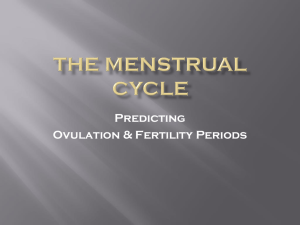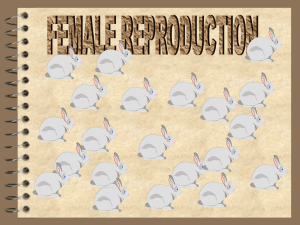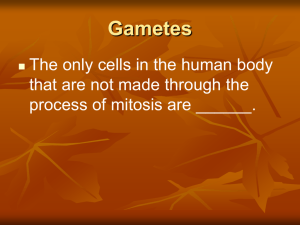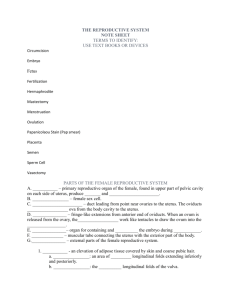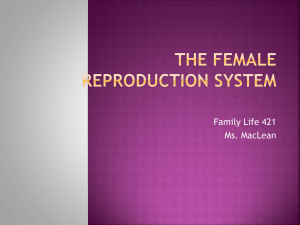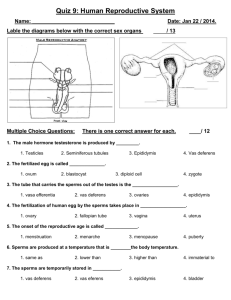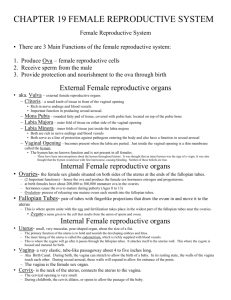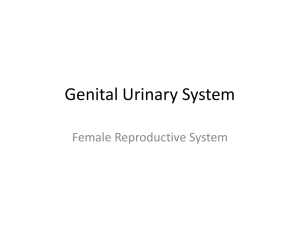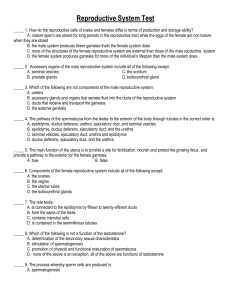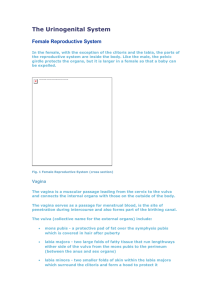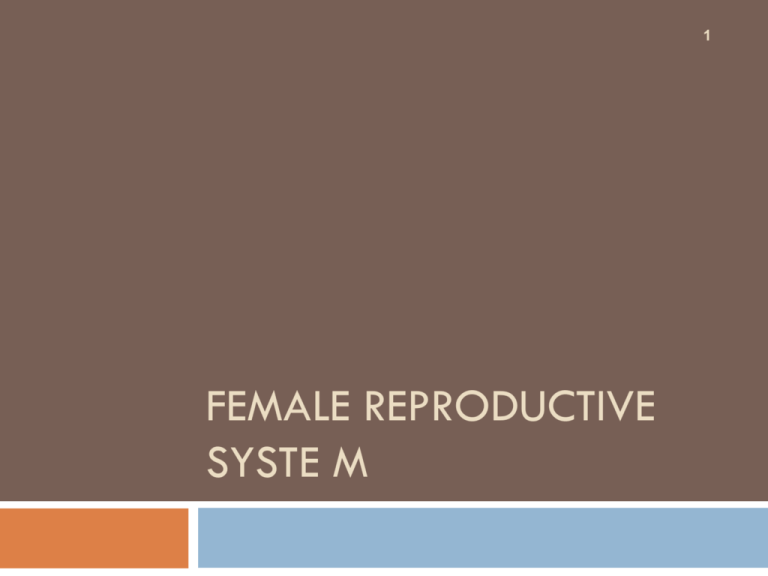
1
FEMALE REPRODUCTIVE
SYSTE M
EXTERNAL GENTILIA
2
The vulva refers to those parts that are outwardly visible
The vulva includes:
Mons pubis
Labia majora
Labia minora
Clitoris
Bartholin’s glands & Skene’s glands –situated within the labia
minora,function is to secrete mucus during sexual arousal
Urethral opening
Vaginal opening
Perineum
3
FEMALE REPRODUCTIVE ANATOMY
4
MONS PUBIS
5
The triangular mound of fatty tissue that covers the
pubic bone
It protects the pubic symphysis
During adolescence sex hormones trigger the
growth of pubic hair on the mons pubis
LABIA MAJORA
6
The Labia Majora:
Are covered with hair and sebaceous glands
Become flaccid with age and after childbirth
LABIA MINORA
7
Made up of erectile, connective tissue that swells
during sexual arousal
Located inside the labia majora
8
CLITORIS
Highly sensitive organ composed of nerves, blood
vessels, and erectile tissue
Located under the prepuce
It is made up of a shaft and a glans
Becomes engorged with blood during sexual
stimulation
PERINEUM
9
The muscle and tissue located between the vaginal
opening and anal canal
It supports and surrounds the lower parts of the
urinary and digestive tracts
The perinium contains an abundance of nerve endings
that make it sensitive to touch
An episiotomy is an incision of the perinium used
during childbirth for widening the vaginal opening
PERINEUM
10
Vestibule
11
Triangular shaped area between the labia
minora.The vagina,urethral opening and ducts of
the greater vestibular glands open into it
VAGINAL OPENING
12
Opening partially covered by a thin sheath
called the hymen
Hymen is a thin membrane of connective tissue
,covered by mucus membrane partially occluding
the opening of the vagina
UNIT 3: FEMALE REPRODUCTIVE SYSTEM
INTERNAL GENITALIA
13
The internal genitalia consists of the:
Vagina
Cervix
Uterus
Fallopian Tubes
Ovaries
14
UNIT 3: FEMALE REPRODUCTIVE SYSTEM
VAGINA
15
The vagina connects the cervix to the external genitals
It is located between the bladder and rectum
Lined by squamous epithelium
It functions :
As a passageway for the menstrual flow
For uterine secretions to pass down through the introitus
As the birth canal during labor
With the help of two Bartholin’s glands becomes lubricated
during SI
Mucus and the low pH makes a hostile environment to sperms
UTERUS
16
A hollow muscular pear shaped organ
It is made up of the endometrium, myometrium and
perimetrium
The powerful muscles of the uterus expand to accommodate a
growing fetus and push it through the birth canal(important in
both pregnancy and labour)
Uterus
17
Endometrium-mucous membrane that lines the inner cavity of the uterus.It
varies in thickness and structure during the menstrual cycle and is shed at
menstruation.site of implantation
Myometrium- muscular middle layer,composed of interlacing spiral muscle
fibres which allow growing and stretching and contracts during labour to
accomadate the fetus
Perimetrium-peritoneal layer forming the outer layer of the uterus
Parts
18
Fundus-upper part,fallopian tubes connected
Body-thick middle tapering section
cervix
CERVIX
19
Has an internal and an external os
This acts as a safety precaution against foreign
bodies entering the uterus
During childbirth, the cervix dilates to accommodate
the passage of the fetus
This dilation is a sign that labor has begun
OVIDUCTS
20
UNIT 3: FEMALE REPRODUCTIVE SYSTEM
FALLOPIAN TUBES
21
Serve as a pathway for the ovum to the uterus
Are the site of fertilization by the male sperm
Funnel shaped tubes-10 cm long
Fertilized egg takes approximately 6 to 10 days to
travel through the fallopian tube to implant in the
uterine lining
Lined by cilliated columnar epi, which assist the
movement of the ovum towards the uterus
22
OVARIES
23
The female gonads or sex glands
They develop and expel an ovum each month
A woman is born with approximately 500,000 immature eggs
called follicles
During a lifetime a woman release 400 to 500 fully matured
eggs for fertilization
The follicles in the ovaries produce the female sex hormones,
progesterone and estrogen
These hormones prepare the uterus for implantation of the
fertilized egg
Ovaries
24
Two almond shaped organs attached to the
ligaments that suspend them in the pelvic cavity
Consists of connective tissue,BV,nerves and follicles
with immature ova
ovulation
25
After puberty,FSH from the pituitary gland
stimulates immature ova to mature each month and
secrete oestrogen
Ovulation is rupture of mature follicle releasing the
ovum into peritoneal cavity which is swept into the
fallopian tube
After ovulation the ruptured follicle changes to the
corpus luteum, which begins to secrete the hormone
progesterone.
Physiology of female reproductive
system
26
the menstrual cycle refers to a cyclic series of
monthly changes that occur to the post puberty
female’s ovaries and uterus – controlled by
hormones.
Every month the endometrium prepares itself for
implantation of the fertilized ovum. If this does not
occur the prepared endometrial lining will be shed.
27
Menarche is the onset of cyclical bleeding. Menstrual
cycle There are three phases:
• Menstrual (lasts approximately five days)
• Pre–ovulatory (proliferative) –vary in length
greatly,starts on D6 and ends 0n D 13.(in 28d
cycle)
• Post–ovulatory (secretory).-from D15-28
The menstrual cycle
28
The ovarian cycle is initiated by a small rise in the level of follicle stimulating hormone (FSH),
which begins late during the preceding menstrual cycle.
This rise stimulates a group of follicles to develop, one of which matures to ovulation.
The mature follicle secretes increasing amounts of oestrogen, which rises to a peak and then
falls before ovulation.
This oestrogen produces recognisable changes in the vaginal cytology, in the endometrium and
in the cervix and cervical secretions.
It also operates a negative feedback mechanism, which decreases FSH production, and a
positive feedback mechanism, which initiates the mid–cycle surge of luteinising hormone (LH).
This surge of LH triggers ovulation. Ovulation is accompanied by a rise in progesterone
production and a second rise in oestrogen production
.Progesterone produces recognisable changes in the endometrium and in the cervical mucous
and causes a rise in the basal body temperature.
Menstruation follows ovulation, after an interval of 14 days.
These cyclical changes provide the markers for timing of ovulation.
Variation in cycle length is due to variation in the pre–ovulatory phase and is caused by a
delay in the FSH secretion to reach a sufficiently high level to stimulate the development of a
new batch of follicles.
MENSTRUATION
29
Menarche, the onset of
menstruation signals the bodily
changes that transform a female
body.Average age is 12.8
Amount of bleeding per
menstruation varies from woman
to woman(35-60ml)
Cycle length varies from 21-35
days
The first day of the menstruation
is the first day of a new
reproductive cycle
Women can experience fluid
retention, cramping, mood
swings, weight gain, breast
tenderness, diarrhea, and
constipation
30
UNIT 3: FEMALE REPRODUCTIVE SYSTEM
PITUITARY HORMONES
31
FOLLICLE DEVELOPMENT
32
OVULATION
33
OVARIAN HORMONES
34
SEX HORMONES
35
Follicle stimulating hormone FHSstimulates follicular growth
Luteinizing hormone -•Essential
for ovulation – causes ovulation
by stimulating the ovarian
membrane to dissolve, allowing
the ovum to be released.
Estrogen- produced throughout
the menstrual cycle
Progesterone-produced during
second half of cycle
Both FHS and LH are
produced in the
anterior pituitary
gland
Both estrogen and
progesterone are
produced by the
follicles in the ovaries
estrogen
36
Primarily develops and maintains secondary sexual
characteristics
Growth and development of the reproductive
organs and the skeleton
Decreases rate of bone re absorption
Reproductive functions –aids fertilization, promotes
development of the endometrial lining, aids
fertilization
Changes the pH of the cervical mucus to assist in
sperm survival
Progesterone
37
Secreted by corpus luteum.
Large amounts secreted following ovulation.
Prepares endometrium for implantation of a
fertilized ovum.
Stimulates mammary glands to produce milk.
Increases body temperature.
Relaxes smooth muscle, uterus and blood vessels.
Activity…
38

